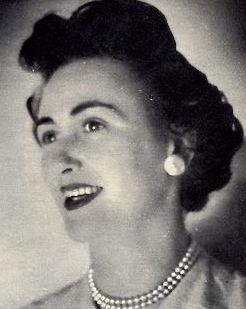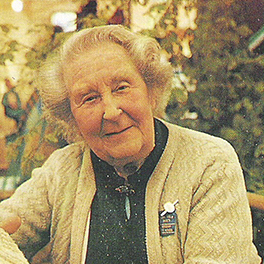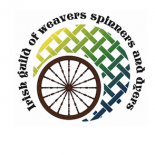
Weaving is a method of textile production in which two distinct sets of yarns or threads are interlaced at right angles to form a fabric or cloth. Other methods are knitting, crocheting, felting, and braiding or plaiting. The longitudinal threads are called the warp and the lateral threads are the weft, woof, or filling. The method in which these threads are interwoven affects the characteristics of the cloth. Cloth is usually woven on a loom, a device that holds the warp threads in place while filling threads are woven through them. A fabric band that meets this definition of cloth can also be made using other methods, including tablet weaving, back strap loom, or other techniques that can be done without looms.

Merrion Square is a Georgian garden square on the southside of Dublin city centre.

Ethel Mary Partridge, Ethel Mary Mairet RDI, or Ethel Mary Coomaraswamy was a British hand loom weaver, significant in the development of the craft during the first half of the twentieth century.

Avoca Handweavers, now mostly known simply as Avoca, is a clothing manufacturing, retail and food business in Ireland. The company began in Avoca, County Wicklow, and is the oldest working woollen mill in Ireland and one of the world's oldest manufacturing companies. Since 2015, it has been owned by the American food service and facilities company, Aramark.

Tweed is a rough, woollen fabric, of a soft, open, flexible texture, resembling cheviot or homespun, but more closely woven. It is usually woven with a plain weave, twill or herringbone structure. Colour effects in the yarn may be obtained by mixing dyed wool before it is spun.

Spinning is an ancient textile art in which plant, animal or synthetic fibres are drawn out and twisted together to form yarn. For thousands of years, fibre was spun by hand using simple tools, the spindle and distaff. After the introduction of the spinning wheel in the 13th century, the output of individual spinners increased dramatically. Mass production later arose in the 18th century with the beginnings of the Industrial Revolution. Hand-spinning remains a popular handicraft.

Sybil Connolly was a celebrated fashion designer and global icon known for her innovative use of traditional Irish textiles in haute couture. Often described as "Dublin's Dior", she achieved international repute and success, making her one of the first Irish designers to do so. She was a member of the "Big Three" Irish fashion designers, and was described by former Taoiseach Jack Lynch as "a national treasure."

The Ontario Handweavers & Spinners (OHS) is a non-profit organization based in Ontario, Canada that helps individuals interested in the fiber crafts to communicate and develop their skills, including weaving, spinning and dying, basket makers, braiders, tablet weavers and paper makers. The OHS communicates to its members through a quarterly newsletter, Fibre Focus, provides educational programs in spinning and weaving, provides scholarships and organizes several seminars or conferences each year.

Muriel Françoise Gahan was an Irish rural campaigner and a promoter of traditional crafts and of the cooperative movement. She commissioned the first adult Aran jumper, launched the Irish Homespun Society and helped lead the Irish Country Markets co-operative for decades. A founding member of Ireland's Arts Council, Gahan played significant roles in the Irish Countrywomen's Association and other bodies. She was the first female vice-president of the Royal Dublin Society and received an honorary doctorate from Trinity College Dublin and the Plunkett Award for Cooperative Endeavour.

Donegal tweed is a woven tweed manufactured in County Donegal, Ireland. Originally all handwoven, it is now mostly machine woven and has been since the introduction of mechanised looms in the 1950s-1960s. Donegal has for centuries been producing tweed from local materials in the making of caps, suits and vests. Towards the end of the eighteenth century, The Royal Linen Manufacturers of Ulster distributed approximately six thousand flax spinning wheels and sixty looms for weaving to various Donegal homesteads. These machines helped establish the homespun tweed industry in nineteenth-century Donegal. Although Donegal tweed has been manufactured for centuries it took on its modern form in the 1880s, largely due to the pioneering work of English philanthropist Alice Rowland Hart.
Ida Mary Lough was a New Zealand weaver, recognised as one of the country's best tapestry makers.

Founded in 1969 to inspire creativity and encourage excellence in the fiber arts, the Handweavers Guild of America, Inc. (HGA), brings together weavers, spinners, dyers, basketmakers, fiber artists, and educators. HGA provides educational programs, conferences, and an award-winning quarterly publication, Shuttle Spindle & Dyepot, to its members as it seeks to increase awareness of and appreciation for the fiber arts.

Kerry Woollen Mills are historic wool mills based just off the Ring of Kerry.
Helen Lillias Mitchell MRDS MRHA was an Irish craft artist and teacher. She was the founder of The Irish Guild of Weavers, Spinners, and Dyers and the Weaving Department of National College of Art and Design.
Neillí Mulcahy was an Irish designer. In 1962, Mulcahy co-founded the Irish Haute Couture Group with Ib Jorgensen and Irene Gilbert.

Alice Hart was a British philanthropist, artist, and businesswoman.
Emily Wynne was an Irish textile artist at Avoca Woollen Mills and author.
Marcella Augusta Hempel, was a textile artist, second generation Bauhaus master weaver and lecturer in textiles. She was one of many émigré artists who came to Australia after the second world war, bringing training and expertise from Europe. She became a respected leader in the Australian Crafts Movement. Hempel designed and wove products such as rugs and scarves which were commissioned or exhibited by Australian companies, private collectors and craft and art galleries. Her work received a gold medal award from the Australian Wool Board. She lectured in Dresden then at the University of Applied Arts in Berlin, taught textile design at East Sydney Technical College, was the inaugural lecturer in textiles at the Riverina-Murray Institute of Higher Education and was conferred with a Honoris Causa award of Bachelor of Arts after retirement. Her woven travel rugs are held in national art collections.

Weavers' Hall was a guildhall at 14 The Coombe, Dublin, Ireland, which housed the Guild of Weavers, one of the 25 Guilds of the City of Dublin. The building was constructed in 1745 to a design by architect Joseph Jarratt to replace an earlier nearby weavers' guildhall in the Lower Coombe which was built in 1681–2 and was located in what was originally the Earl of Meath's Liberty. The building was demolished in 1965, with elements including furniture, fireplaces, door surrounds and stone floors sold off as scrap.

Mabel Burnside Myers (1922–1987) was a Diné weaver, herbalist and sheepherder. She is known for being the first Indigenous weaver to create dye charts for teaching students.















